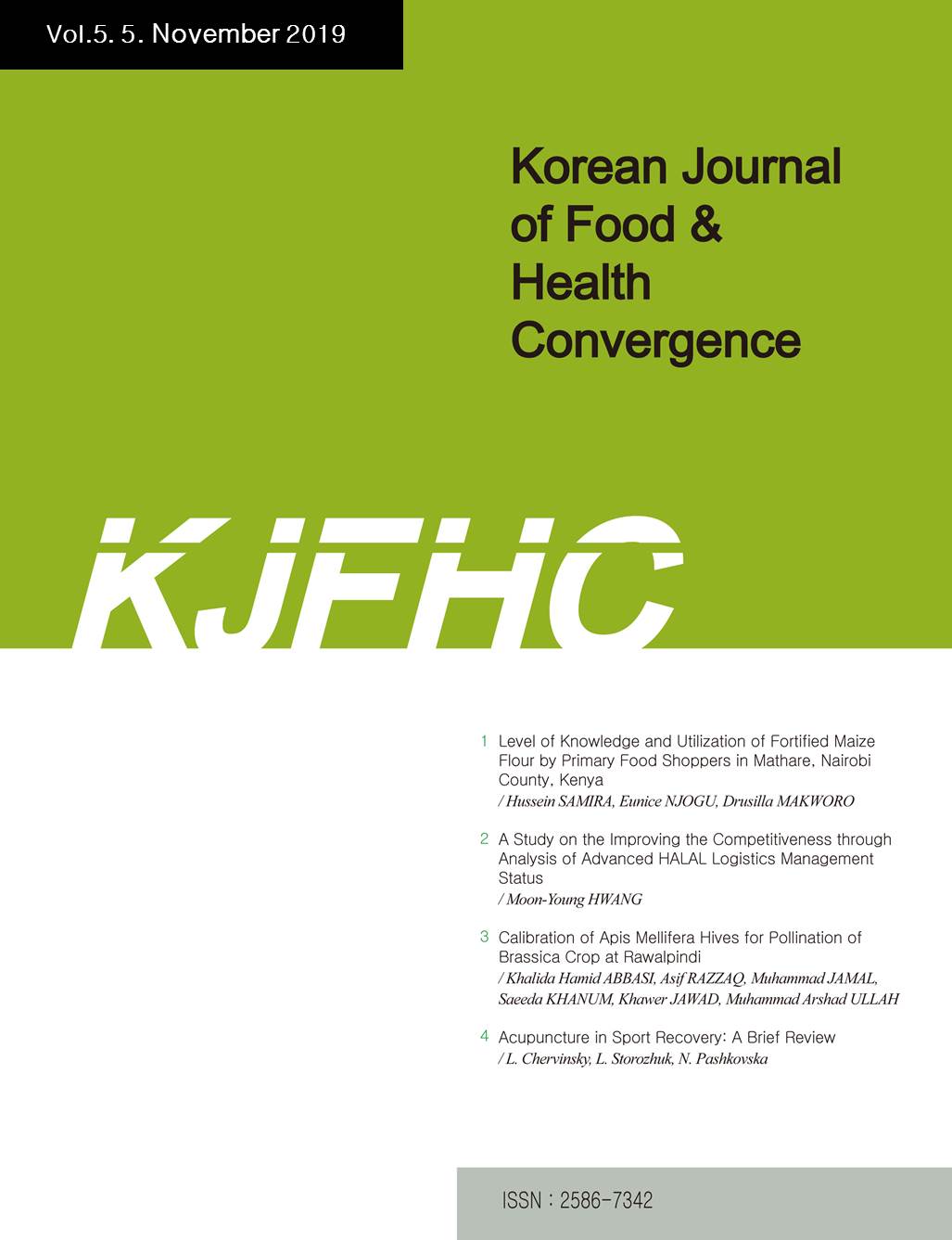 E-ISSN : 2586-7342
E-ISSN : 2586-7342
Vol.6 No.2
Abstract
Micronutrient malnutrition severely affects development and functioning of the body leading to increased morbidity and mortality. The study adopted a cross-sectional research design; cluster sampling was used to target 318 households. The significance level was P < 0.05, the mean age of primary food shoppers was 33 years and the average income was 3,000-5,000 Kenya shillings. Slightly above half, 55% of the primary food shoppers knew about fortification but only 25% understood its meaning. Fortified maize flour was consumed by < 80% of primary food shoppers however utilization frequency was low. In conclusion factors that were significantly associated with utilization of fortified maize flour included; knowledge on fortified maize flour (p=0.00), household size (p=0.005), preference of fortified maize flour (p=0.000) and level of fortification knowledge (p=0.002). Availability and price were ranked as the most important factors that influence utilization of fortified maize flour at 58% and 55% contrary nutritional value was ranked least important at 37%. The ministry of health and concerned millers should make more emphasis on creating and sustaining awareness more so a steady supply and affordable prices should be ensured by millers so that more primary food shoppers can be able to utilize the fortified maize flour.
Abstract
The global halal market is forecast to grow at an annual average of 5.2 percent from 2017 to $3.07 trillion in 2023 due to the high growth rate of the world's Muslim population, the spread of halal-certified food consumption and the economic growth of the Muslim world. Through this study, the difficulty of obtaining halal certification can be overcome through accurate understanding of the general supply chain and other halal supply chain. Also, by examining the trends and requirements of halal logistics standards in countries with advanced halal logistics systems, halal logistics certification agencies, and halal port logistics, we can help establish our own halal logistics system by finding areas that can be benchmarked in Korea and differentiated from those that can be found. For the safe supply chain management of halal products between logistics Supply Chain, an integrated logistics system shall be developed to manage customs and customs as one-stop, while maintaining a complete halal condition on a series of logistics processes such as storage, transportation, customs clearance, etc. Korea, entry into the halal logistics market through halal integrity guarantee solution or platform development can also be considered, taking advantage of the strength of IT and packaging.
Abstract
The response of honeybee (Apis mellifera L.) pollination on canola yield with reference to most suitable number of bee hive need per unit area of crops in order to meet optimum pollination needs and better economic yields by comparing number of hives and yield components an experiment was conducted at Beekeeping and Hill Fruit Pests Research, Station Rawalpindi during 2017-18 in complete randomized block design with two sets of four treatments for comparison: 1 hive acre<sup>-1</sup>, 2 hives acre<sup>-1</sup>, 3 hives acre<sup>-1</sup> and 0 hive acre<sup>-1</sup>. The hives were kept inside the experimental area. Parameters were assessed: pollination density, pollinator's diversity, agronomic and economic yield. In case of pollination density, the cumulative mean abundance bee species revealed that at 1200 hours, Apis mellifera was the most abundant and frequent visitor with a mean population of 8.69 bees/plant followed by A. dorsata (0.72), Syrphid fly (0.2) and other pollinators. Minimum bee population was observed during 1400 hours, mainly due to the closure of flowers and partially due to high temperature (>35℃). Pollinator diversity revealed that A. mellifera was the most dominant pollinator of Brassica crop with highest abundance (71%). A. dosata ranked 2<sup>nd</sup> (16%) followed by A. florea (6%) respectively.
Abstract
Active and therapeutic sport recovery is becoming a popular and important component in approving performance for pro and recreational athletes alike. It is also helping in the realm of injury prevention. In the search of finding modalities that are widely effective, natural, and safe, acupuncture is a viable and cost-effective treatment for helping athletes achieve this goal. More direct related research is needed, but testimonials from pro athletes and the body of research that currently exists provides powerful evidence on acupunctures ability to help with enhancing recovery. Specializing in acupuncture and exercise science, Chris integrates acupuncture into musculoskeletal rehabilitation therapy or fitness training for pain modulation, speedy recovery, and enhanced performance. Clients can choose to focus on one-on-one corrective exercise therapy, manual and massage therapy, or acupuncture. However, for best results, Chris recommends all three. Other modalities that he uses in therapy are acu-taping, herbal therapy, nutrition supplementation, cupping, guasha, and stretching techniques. The corrective exercise component is one-on-one body balancing management, focusing on strength and conditioning, post physical rehab - exercise therapy, integrative sport specific exercise, weight loss, core strengthening, dynamic lumbar stabilization, active recovery techniques, and myo-fascial release techniques. The acupuncture component focuses on sport injuries, myofascial pain, peripheral neuropathy, arthritis, facial rejuvenation, stress, smoking cessation, addiction detoxification program, weight management, sport recovery and performance.
